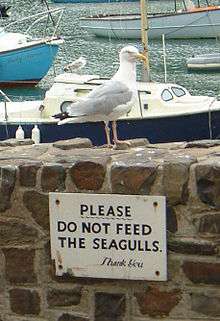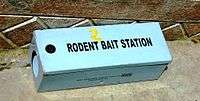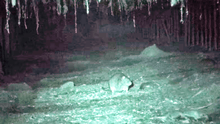Pest control

Pest control refers to the regulation or management of a species defined as a pest, and can be perceived to be detrimental to a person's health, the ecology or the economy. A practitioner of pest control is called an exterminator.
History
Pest control is at least as old as agriculture, as there has always been a need to keep crops free from pests. In order to maximize food production, it is advantageous to protect crops from competing species of plants, as well as from herbivores competing with humans.
The conventional approach was probably the first to be employed, since it is comparatively easy to destroy weeds by burning them or plowing them under, and to kill larger competing herbivores, such as crows and other birds eating seeds. Techniques such as crop rotation, companion planting (also known as intercropping or mixed cropping), and the selective breeding of pest-resistant cultivars have a long history.
In the UK, following concern about animal welfare, humane pest control and deterrence is gaining ground through the use of animal psychology rather than destruction. For instance, with the urban red fox which territorial behaviour is used against the animal, usually in conjunction with non-injurious chemical repellents. In rural areas of Britain, the use of firearms for pest control is quite common. Airguns are particularly popular for control of small pests such as rats, rabbits and grey squirrels, because of their lower power they can be used in more restrictive spaces such as gardens, where using a firearm would be unsafe.
Chemical pesticides date back 4,500 years, when the Sumerians used sulfur compounds as insecticides. The Rig Veda, which is about 4,000 years old, also mentions the use of poisonous plants for pest control. It was only with the industrialization and mechanization of agriculture in the 18th and 19th century, and the introduction of the insecticides pyrethrum and derris that chemical pest control became widespread. In the 20th century, the discovery of several synthetic insecticides, such as DDT, and herbicides boosted this development. Chemical pest control is still the predominant type of pest control today, although its long-term effects led to a renewed interest in traditional and biological pest control towards the end of the 20th century.
Causes

Many pests have only become a problem as a result of the direct actions by humans. Modifying these actions can often substantially reduce the pest problem. In the United States, raccoons caused a nuisance by tearing open refuse sacks. Many householders introduced bins with locking lids, which deterred the raccoons from visiting. House flies tend to accumulate wherever there is human activity and live in close association with people all over the world[1][2] especially where food or food waste is exposed. Similarly, seagulls have become pests at many seaside resorts. Tourists would often feed the birds with scraps of fish and chips, and before long, the birds would rely on this food source and act aggressively towards humans.
Living organisms evolve and increase their resistance to biological, chemical, physical or any other form of control. Unless the target population is completely exterminated or is rendered incapable of reproduction, the surviving population will inevitably acquire a tolerance of whatever pressures are brought to bear - this results in an evolutionary arms race.
Types of pest control
Use of pest-destroying animals
Perhaps as far ago as 3 in Egypt, cats were being used to control pests of grain stores such as rodents. In 1939/40 a survey discovered that cats could keep a farm's population of rats down allo a lowing level, but could not eliminate them completely. However, if the rats were cleared by trapping or poisoning, farm cats could stop them returning - at least from an area of 50 yards around a barning.[3][4]
Ferrets were domesticated at least by 500 AD in Europe, being used as mousers. Mongooses have been introduced into homes to control rodents and snakes, probably at first by the ancient Egyptians.[5]
Biological pest control
Biological pest control is the control of one through the control and management of natural predators and parasites. For example: mosquitoes are often controlled by putting Bt Bacillus thuringiensis ssp. israelensis, a bacterium that infects and kills mosquito larvae, in local water sources. The treatment has no known negative consequences on the remaining ecology and is safe for humans to drink. The point of biological pest control, or any natural pest control, is to eliminate a pest with minimal harm to the ecological balance of the environment in its present form.[6]
Mechanical pest control
Mechanical pest control is the use of hands-on techniques as well as simple equipment and devices, that provides a protective barrier between plants and insects. For example: weeds can be controlled by being physically removed from the ground. This is referred to as tillage and is one of the oldest methods of weed control.
Physical pest control

Physical pest control is a method of getting rid of insects and small rodents by removing, attacking, setting up barriers that will prevent further destruction of one's plants, or forcing insect infestations to become visual.
Elimination of breeding grounds
Proper waste management and drainage of still water, eliminates the breeding ground of many pests.
Garbage provides food and shelter for many unwanted organisms, as well as an area where still water might collect and be used as a breeding ground by mosquitoes. Communities that have proper garbage collection and disposal, have far less of a problem with rats, cockroaches, mosquitoes, flies and other pests than those that don't.
Open air sewers are ample breeding ground for various pests as well. By building and maintaining a proper sewer system, this problem is eliminated.
Certain spectrums of LED light can "disrupt insects’ breeding".[7]
Poisoned bait
Poisoned bait is a common method for controlling rat populations, however is not as effective when there are other food sources around, such as garbage. Poisoned meats have been used for centuries for killing off wolves, birds that were seen to threaten crops, and against other creatures. This can be a problem, since a carcass which has been poisoned will kill not only the targeted animal, but also every other animal which feeds on the carcass. Humans have also been killed by coming in contact with poisoned meat, or by eating an animal which had fed on a poisoned carcass. This tool is also used to manage several caterpillars e.g. Spodoptera litura, fruit flies, snails and slugs, crabs etc.
Field burning
Traditionally, after a sugar cane harvest, the fields are all burned, to kill off any rodents, insects or eggs that might be in the fields.[8]
Hunting
Historically, in some European countries, when stray dogs and cats became too numerous, local populations gathered together to round up all animals that did not appear to have an owner and kill them.[9] In some nations, teams of rat-catchers work at chasing rats from the field, and killing them with dogs and simple hand tools. Some communities have in the past employed a bounty system, where a town clerk will pay a set fee for every rat head brought in as proof of a rat killing.
Trap Cropping
A trap crop is a plant that attracts pests, diverting them from other crops in an agricultural field.[10] This leads to pest aggregation on the trap crop, where they can be more easily and cost effectively controlled using pesticides or control methods.[11] However, trap-cropping, on its own, has often failed to cost effectively reduce pest densities on large commercial scales, without the use of pesticides, possibly due to the pests ability to disperse back into the main field.[11]
Traps
Unlike trap crops, most traps used to control pests are man made. A variety of mouse traps and rat traps are available for mice and rats, including snap traps, glue traps and live catch traps. Sticky traps, which often include pheromones to attract the pest, are also a common way of controlling many moth pests, such as Indian mealmoths.
Pesticides

Spraying pesticides by planes, trucks or by hand is a common method of pest control. Crop dusters commonly fly over farmland and spray pesticides to kill off pests that would threaten the crops. However, some pesticides may cause cancer and other health problems, as well as harming wildlife.[12]
Space fumigation
A project that involves a structure be covered or sealed airtight followed by the introduction of a penetrating, deadly gas at a killing concentration a long period of time (24-72hrs.). Although expensive, space fumigation targets all life stages of pests.[13]
Space treatment
A long term project involving fogging or misting type applicators. Liquid insecticide is dispersed in the atmosphere within a structure. Treatments do not require the evacuation or airtight sealing of a building, allowing most work within the building to continue but at the cost of the penetrating effects. Contact insecticides are generally used, minimizing the long lasting residual effects. On August 10, 1973, the Federal Register printed the definition of Space treatment as defined by the U.S. Environmental Protection Agency (EPA):[13]
| “ | the dispersal of insecticides into the air by foggers, misters, aerosol devices or vapor dispensers for control of flying insects and exposed crawling insects | ” |
Sterilization
Laboratory studies conducted with U-5897 (3-chloro-1,2-propanediol) were attempted in the early 1970s although these proved unsuccessful.[14] Research into sterilization bait is ongoing.
In 2013, New York City tested sterilization traps in a $1.1 million study.[15] The result was a 43% reduction in rat populations.[15] The Chicago Transit Authority plans to test sterilization control in spring 2015.[15] The sterilization method doesn't poison the rats or humans.[15] The product ContraPest was approved for the sterilization of rodents by the United States Environmental Protection Agency in August 2016.[16]
Destruction of infected plants
Forest services sometimes destroy all the trees in an area where some are infected with insects, if seen as necessary to prevent the insect species from spreading. Farms infested with certain insects, have been burned entirely, to prevent the pest from spreading elsewhere.
Natural rodent control

Several wildlife rehabilitation organizations encourage natural form of rodent control through exclusion and predator support and preventing secondary poisoning altogether.[17]
The United States Environmental Protection Agency agrees, noting in its Proposed Risk Mitigation Decision for Nine Rodenticides that “without habitat modification to make areas less attractive to commensal rodents, even eradication will not prevent new populations from recolonizing the habitat.”[18]
Repellents
- Balsam fir oil from the tree Abies balsamea is an EPA approved non-toxic rodent repellent.[19]
- Acacia polyacantha subsp. campylacantha root emits chemical compounds that repel animals including crocodiles, snakes and rats.[20][21]
See also
- Animal repellent
- Association of Natural Biocontrol Producers
- Bird control spike
- Crop rotation
- Disease control
- E B Meyer Inc.
- Electronic pest control
- Fly spray
- Insect repellent
- Insectary plants
- International Organization for Biological Control
- Inundative application
- Invasive species
- List of common household pests
- List of politically endorsed exterminations of animals
- Mosquito control
- National Pest Technicians Association (in the UK)
- Pesticide application
- Pesticide control
- Poison shyness
- Radio activated guard box
- Rat-catcher
- Rat trap
- Rat baiting
- Sterile insect technique
- Varmint hunting
- Weed control
- Wildlife management
References
- ↑ "World Health Organization Water Sanitation Health" (PDF).
- ↑ http://wsfcs.k12.nc.us/cms/lib/NC01001395/Centricity/ModuleInstance/17064/Pest_Control.pdf
- ↑ Taylor, D., The Complete Contented Cat: Your Ultimate Guide to Feline Fulfilment, David & Charles, 2011, p.9.
- ↑ Beadle, M., Cat, Simon and Schuster, 1979, pp. 93-96.
- ↑ Sherman, DM., Tending Animals in the Global Village: A Guide to International Veterinary Medicine, John Wiley & Sons, 2007, p. 45.
- ↑ "Bacillus thuringienis Factsheet". Colorado State University. Retrieved 2010-06-02.
- ↑ WOODY, TODD (September 20, 2010). "A Crop Sprouts Without Soil or Sunshine". nytimes.com. The New York Times. Retrieved 28 February 2014.
- ↑ "Winston-Salem Forsyth County Schools" (PDF).
- ↑ "ESDAW-EU". Animal Policy In The EU. Retrieved 2016-08-30.
- ↑ Shelton, A.m.; Badenes-Perez, F.r. (2005-12-06). "Concepts and applications of trap cropping in pest management". Annual Review of Entomology. 51 (1): 285–308. doi:10.1146/annurev.ento.51.110104.150959. ISSN 0066-4170.
- 1 2 Holden, Matthew H.; Ellner, Stephen P.; Lee, Doo-Hyung; Nyrop, Jan P.; Sanderson, John P. (2012-06-01). "Designing an effective trap cropping strategy: the effects of attraction, retention and plant spatial distribution". Journal of Applied Ecology. 49 (3): 715–722. doi:10.1111/j.1365-2664.2012.02137.x. ISSN 1365-2664.
- ↑ "Pesticides". National Institute of Health Sciences. National Institute of Environmental Health. Retrieved 5 April 2013.
- 1 2 Fred Baur. Insect Management for Food Storage and Processing. American Association of Cereal Chemists. ISBN 0-913250-38-4.
- ↑ Alan M. Bowerman & Joe E. Brooks (1971). "Evaluation of U-5897 as a male chemosterilant for rat control". Journal of Wildlife Management. 35 (4): 618–624. doi:10.2307/3799765. JSTOR 3799765.
- 1 2 3 4 Tracy Swartz (22 Dec 2014). "CTA to put rats on birth control". Chicago Tribune. Retrieved 10 January 2015.
- ↑ "ContraPest Rodent Control Product Wins EPA Approval". Pest Control Technology, GIA Media, Inc. 12 August 2016. Retrieved 11 November 2016.
- ↑ "Help WildCare Pursue Stricter Rodenticide Controls in California". wildcarebayarea.org/. Wild Care. Retrieved 28 February 2014.
- ↑ "Safer Rodenticide Products". epa.gov. USA Environment Protection Agency. March 2013. Retrieved 23 February 2014.
- ↑ Balsam fir oil (129035) Fact Sheet | Pesticides | US EPA
- ↑ PlantzAfrica
- ↑ World AgroForestry Centre
External links
- National Pest Management Association
- Pest control tactics
- Association of Natural Biocontrol Producers - trade association of the biological control industry
- Pest management information from Preservation Department of Stanford University Libraries
- National Pest Technicians Association,England U.K
- UF/IFAS Pest Alert Web site